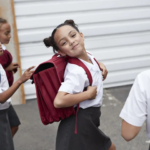
13 Jul Things parents need to know if their child is heading for high school.
What factors are involved for children making the transition from primary to secondary school?
“Kids need to feel confident about coming to high school, and to feel comfortable there. The more they visit, look around, talk to teachers, talk to the big kids, the better off they are.”
Starting school is a big deal for littlies and their parents, but the transition from primary school to secondary school receives less attention. Yet it marks another significant milestone in children’s lives, and young people’s wellbeing and academic success can be profoundly affected by how it all goes. A smooth transition lays the foundations for a happier high school experience.
Imagine how a child of 10 or 11 feels about leaving the security of a smaller school, where they’ve been among the eldest students for a couple of years, where they know most teachers, and where the routine is familiar. They are heading for the big unknown. “Only one other friend is going to the same school as me,” Tahlia tells me. “Mum says I’ll make other friends, but I’m scared I won’t.” And Vincent says that he’s worried about all the homework expected at high school. “My cousin says he never has time to play or do things anymore because he’s always doing schoolwork,” he says. “I like sport and stuff so the high school doesn’t sound like much fun to me.”
Tahlia and Vincent echo the concerns of many children as they gear up for secondary school. Starting high school means being the smallest and the youngest in a larger school population, managing a new curriculum with many different subjects, adapting to the teaching strategies of a range of different teachers, and facing new academic expectations. What’s more, the transition from primary school marks the shift out of childhood into adolescence and puberty, with all the attendant physical, intellectual and emotional changes. It’s no wonder that so many kids feel anxious around this time. “It was very scary to take that step,” says Kristy, who is now in her fourth year of high school. “I was lucky because I had a big sister to look out for me, but most other kids didn’t have that.”
Across Australia, education departments have recognised the needs of children in what is known as ‘the middle years’ of school, from Years 5 to 9, giving particular attention to the transition from primary school to high school.
A lot of work is already being done to effect smooth transitions in schools right across Australia, as Departments of education in all States and Territories have focused on helping students with this important stage of their lives.
An important aspect of the strategy is good contact between primary schools and the secondary schools that students will be attending. When secondary schools draw on just two or three local primary schools, they can work together very directly and effectively. But when students come from 15 to 20 schools over a large area, it is a challenge to put comprehensive support systems in place while all of these students are still in primary school.
“Kids need to feel confident about coming to high school and to feel comfortable there. The more they visit, look around, talk to teachers, talk to the big kids, the better off they are. We also like to have high-school teachers and students from the first year of high school going to talk to them, to let them know that they don’t have to worry, that everything can be sorted out.” Said retired Principal, Brian Ralph.
Peer Support Programs
Many schools rely on a peer-support program to help students settle into secondary school. A longitudinal study conducted by the University of Western Sydney looked at elements of the transition period and found that running an effective peer-support program helps to equip students to successfully negotiate the transition. Central to the peer-support model is connecting new students with older students who have been trained to listen well and answer the younger students’ concerns.
The Peer Support Foundation’s transition program addresses organisational issues, teaching students how to read a timetable and how to find their way around a really large space. They urge parents to listen to their children’s concerns and validate them. “For some kids, it can be a frightening experience. They also suggest that children maintain some continuity outside school, carrying on with a sport or other activity as they make the move from primary to secondary school.
Children with learning difficulties
The transition to high school can be especially difficult for children with learning difficulties. Robert’s son, Sam, started at an inner-city high school in Sydney. Sam was anxious about severe dyslexia that had dogged him in primary school, but his parents met with several of the high school staff to discuss how Sam’s learning might be handled. Months later, Robert says his son came home happy each afternoon. “I think it’s because he feels there’s a place for him there. We wanted him to attend this school because I’d heard it’s very good at this transition stage.”
Robert believes it’s important for parents to be available and involved throughout their children’s schooling. “When Sam was in primary school, I went to working bees every second weekend. It was hard because of my demanding job, but I thought it was important. When he was about to start high school, I participated in everything they offered to parents. I’ve also donated books to the art department. Sam is good at art, it’s one of his talents.”
But parents need to be patient, he says. He once returned from a parent/teacher evening, where some of Sam’s teachers were unaware of his dyslexia and interpreted his difficulties as his not trying hard enough. “It’s a bit frustrating that the information didn’t filter through,” says Robert, “but I do understand how busy teachers are. It just goes to show that as a parent you have to keep up that communication with your child’s teachers, especially if there’s been any kind of difficulty.”
Illustration by Julie Knoblock. Original story by Angela Rossmanith.







